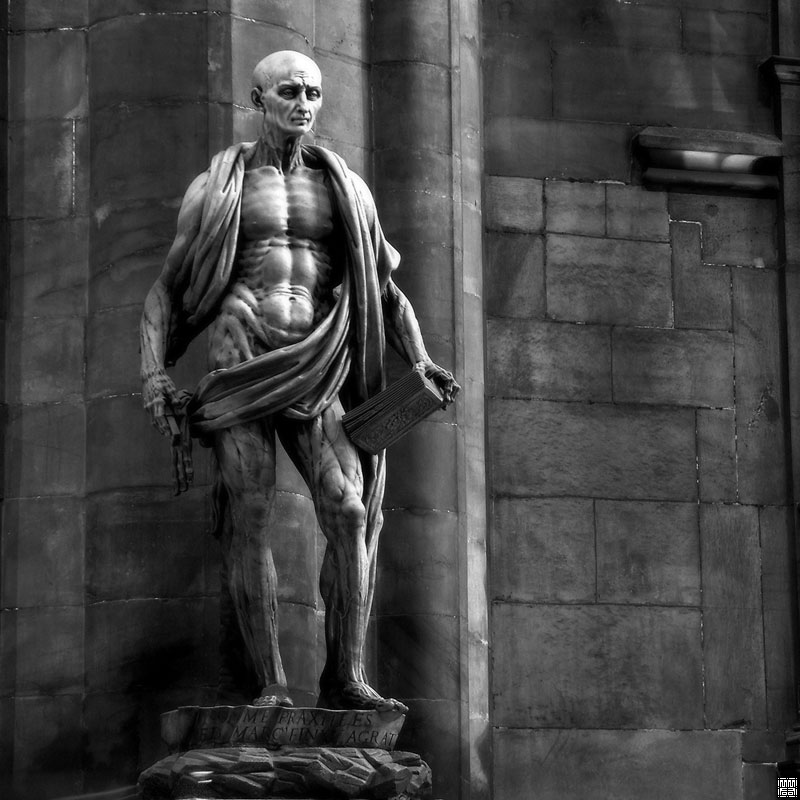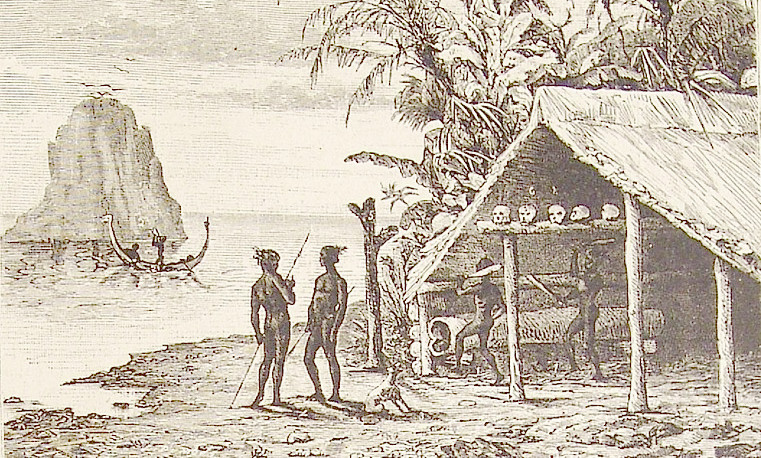
The transept of the Cathedral of Milan features a 1562 statue of the flayed Christian martyr Saint Bartholomew wearing his own skin as a robe.
It’s inscribed I was made not by Praxiteles but by Marco d’Agrate.

The transept of the Cathedral of Milan features a 1562 statue of the flayed Christian martyr Saint Bartholomew wearing his own skin as a robe.
It’s inscribed I was made not by Praxiteles but by Marco d’Agrate.
If a tetrahedron is constructed on a base with side lengths 125, 244, 267, then the remaining sides can take the shapes of three right triangles: (44, 240, 244), (44, 117, 125), (117, 240, 267).
And now the sum of the squares of the lengths of each pair of opposite sides in the tetrahedron is the same:
1172 + 2442 = 1252 + 2402 = 442 + 2672 = 73225
(From Edward Barbeau, Power Play, 1997.)
In “Freaks of the Telegraph,” an 1881 article in Blackwood’s Magazine, Charles Lewes points out that in Morse code the words BAD (-… .- -..) and DEAD (-.. . .- -..) differ only by the space between the D and E in DEAD.
This could result in a sentence such as MOTHER WAS BAD BUT NOW RECOVERED being interpreted strangely as MOTHER WAS DEAD BUT NOW RECOVERED. “Of course, in this case a telegraph operator (short of believing in zombies) would likely notice something was amiss and ask for confirmation of the message — or else attempt to correct it himself,” writes N. Katherine Hayles in How We Think.
But correcting it himself could lead to further misunderstandings. Lewes gives one example: “A lady, some short time since, telegraphed, ‘Send them both thanks,’ by which she meant, ‘Thank you; send them both’ — (the ‘both’ referred to two servants). The telegram reached its destination as ‘Send them both back,’ thus making sense as the official mind would understand it, but a complete perversion of the meaning of the writer.”
According to local folklore, the village of Nigg, Scotland, vanquished cholera in a singularly direct way:
In a central part of the churchyard of Nigg there is a rude undressed stone, near which the sexton never ventures to open a grave. A wild apocryphal tradition connects the erection of this stone with the times of the quarantine fleet. The plague, as the story goes, was brought to the place by one of the vessels, and was slowly flying along the ground, disengaged from every vehicle of infection, in the shape of a little yellow cloud. The whole country was alarmed, and groups of people were to be seen on every eminence, watching with anxious horror the progress of the little cloud. They were relieved, however, from their fears and the plague by an ingenious man of Nigg, who, having provided himself with an immense bag of linen, fashioned somewhat in the manner of a fowler’s net, cautiously approached the yellow cloud, and, with a skill which could have owed nothing to previous practice, succeeded in enclosing the whole of it in the bag. He then secured it by wrapping it up carefully, fold after fold, and fastening it down with pin after pin; and as the linen was gradually changing, as if under the hands of the dyer, from white to yellow, he consigned it to the churchyard, where it has slept ever since.
From Hugh Miller, Scenes and Legends of the North of Scotland, 1835.
In 1728 English surgeon William Cheselden removed the cataracts from a 13-year-old boy, producing the first known case of full recovery from blindness:
Having often forgot which was the cat, and which the dog, he was ashamed to ask; but catching the cat, which he knew by feeling, he was observed to look at her steadfastly and then, setting her down said, ‘So, puss, I shall know you another time.’ He was very much surprised, that those things which he had liked best, did not appear most agreeable to his eyes, expecting those persons would appear to be most beautiful that he loved most, and such things to be most agreeable to his sight, that were so to his taste.
Also: “Being shewn his father’s picture in a locket at his mother’s watch, and told what it was, he acknowledged the likeness, but was vastly surprised; asking, how it could be, that a large face could be expressed in so little room, saying, it should have seemed as impossible for him, as to put a bushel of anything into a pint.” A fuller account is here. See also Molyneaux’s Problem.

The smokestack of the local power plant in Turku, Finland, bears the first ten numbers of the Fibonacci sequence in glowing letters seven feet high.
The artist, Mario Merz, had been obsessed with the sequence for nearly 30 years when he added the numbers in 1995; he’d already added them to a chapel in Paris and a spire in Turin.
“It is entirely by accident that the sequence reflects two of the major research fields of the University of Turku, namely, number theory and mathematical biology,” write mathematicians Mats Gyllenberg and Karl Sigmund. “As is well known, Fibonacci introduced the sequence at around AD 1200 to model the growth of a rabbit population.”
(Mats Gyllenberg and Karl Sigmund, “The Fibonacci Chimney,” Mathematical Intelligencer 22:4 [2000], 46.)
In 1907, two boys in Alameda, Calif., used homemade wireless sets to intercept messages sent from Navy ships to “boudoirs ashore”:
Miss Brown, Oakland — Can’t meet you to-night. No shore leave. Be good in the meantime.
Mrs. Blank, Alameda — Will see you sure to-morrow night. Didn’t like to take too many chances yesterday. We must be discreet.
[from an officer to a woman on Mare Island:] Honestly, could not show last night. Am arranging so I can see you oftener. Will take you to dinner Wednesday afternoon.
A married woman on Mare Island wrote to another woman’s husband, an officer, “All lovely. I’m sure you are mistaken. Call again. Your P.L.”
“Debutantes, it appears, use the wireless system of the navy to relieve their irksome task of correspondence, for there are many fond messages in the book from evidently ingenuous girls to midshipmen and other young officers,” reported the San Francisco Examiner. “At least a third of the messages belong to the class that can not be regarded in any light but confidential without inverting all accepted canons of discretion.”
“Technology is the reason we get old enough to complain about technology.” — Garry Kasparov

In 1868, Scottish sailor Jack Renton found himself the captive of a native people in the Solomon Islands, but through luck and skill he rose to become a respected warrior among them. In this week’s episode of the Futility Closet podcast we’ll tell the story of Renton’s life among the saltwater people and his return to the Western world.
We’ll also catch some more speeders and puzzle over a regrettable book.